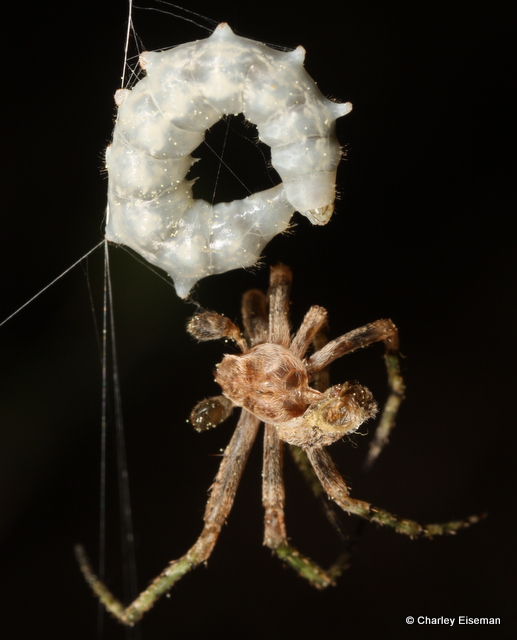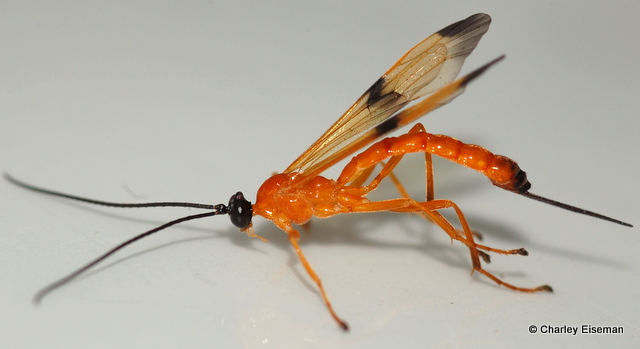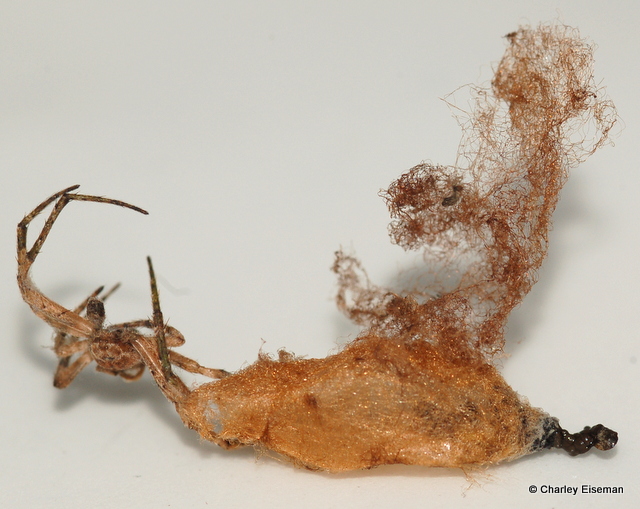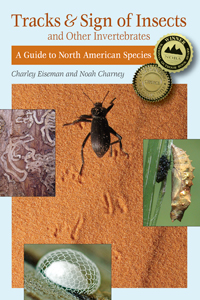I have much too much going on right now to be writing blog posts, but I’m waiting for an oil change at the moment, so let’s see what I can do…
On the first night of our road trip we camped in eastern South Carolina by a small oxbow pond from which enormous fish were constantly leaping out and splashing back in. In the morning we wandered around nearby to see what leaf mines there were to be found, and I spotted something I had seen before in pictures but never in person:
It was a mature larva of an ichneumon wasp in the Polysphincta genus group, which had finished sucking the life out of its spider host and was now hanging in the web, with the spider’s carcass dangling below it. (I had seen very young larvae before, as shown in the last photo here, but this was the first time I had seen a mature larva with those distinctive leglike projections.)
My past attempt to raise a parasitized spider had failed, but to raise this larva all I had to do was throw it in a vial and wait. A few days later we visited Troy Bartlett, and I asked his opinion on this spider with green-tipped legs. He suggested an immature male Giant Lichen Orbweaver (Araneus bicentenarius), and when I posted a photo of it on BugGuide, Lynette Schimming independently made the same suggestion. I’m not aware of another viable candidate, so it seems likely that’s what it was.
The larva was lying motionless every time I checked on it, but then one day it had spun a loose cocoon at the bottom of the vial.
(My car was ready at this point, but I’m so close, might as well just finish it.)
Two and a half weeks after I collected the larva, this brightly colored wasp emerged:
Since it was so distinctive and I already knew from its natural history that it was a member of the Polysphincta genus group, I tried out BugGuide’s browse function and quickly found a clear match: Acrotaphus wiltii. The single example on BugGuide of a reared specimen of this species is here–a wasp that found itself trapped inside a mud cell after the spider that it parasitized as a larva was abducted by an organ pipe mud dauber, which used the spider to provision its nest. I gather from Bob Carlson’s comment there that the only known host of A. wiltii is Neoscona arabesca, the Arabesque Orbweaver, which this spider with green-tipped legs clearly was not.
In the cocoon photo above, the larva had not yet pupated. If I remember correctly what Howard Ensign Evans wrote in Wasp Farm, all wasp larvae have the same habit of saving up all their excrement until just before pupating and then expel it all at once. In the case of this ichneumon, the excrement was pushed outside the cocoon, as can be seen in this photo taken after I removed the empty cocoon from the vial:









This is such an interesting post! What will the wasp do now as an adult? What does it eat?
I’ve occasionally seen adult ichneumons visiting flowers for nectar. Mainly, adults mate and then look for suitable hosts to lay eggs in!
Would there be any value to sequencing the dna of the frass of the wasp to discover if there is anything that can be learned about it and/or its host?
I still have the spider remains, and sequencing its DNA would settle the matter of its identity, if there is a lab out there that would be willing to do that.
Pingback: Previews of Parasitoids | BugTracks
I have seen this wasp on 3 occasions in the UK in the last week , is this normal in the UK as know one I have spoke to or showed the photo to has seen this wasp , Ever ?. The wasp was about 75mm in length . Ian from Chester , England
Sorry, I have no idea… but it sounds like you are seeing a different wasp, since 75 mm is many times larger than this species.